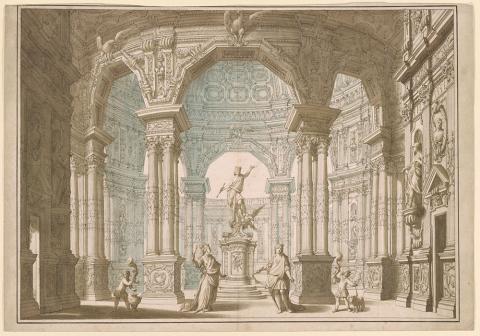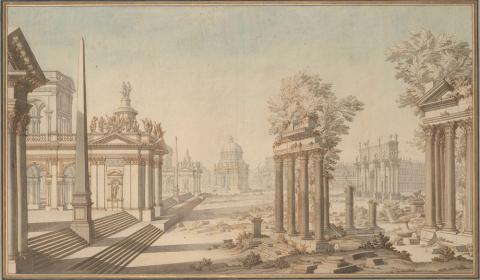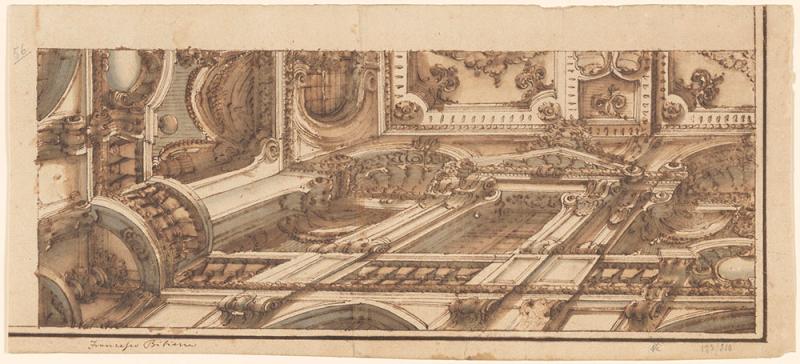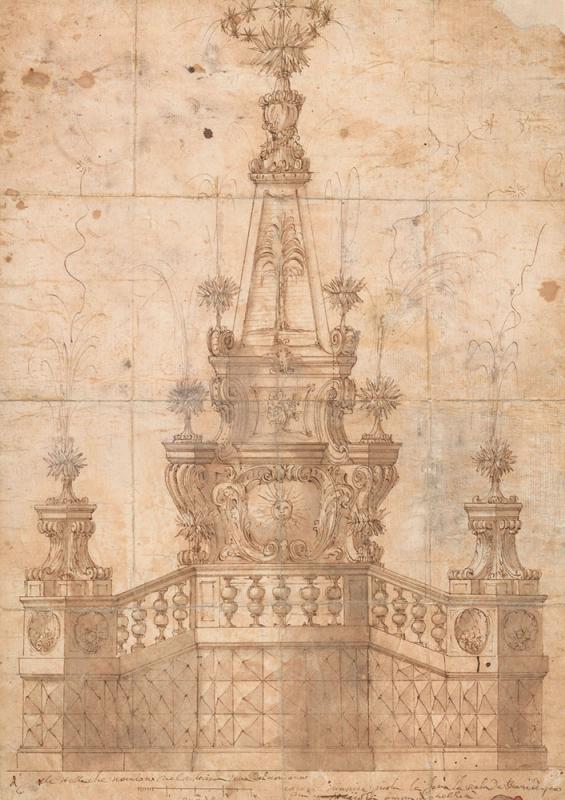Note: The following text is extracted from the catalogue of the Morgan's exhibition Architecture, Theater, and Fantasy: Bibiena Drawings from the Jules Fisher Collection, a show that celebrates the promised gift of a group of Bibiena drawings. This essay aims to put the new drawings in the context of the Morgan's existing collection, and to discuss the collecting of Bibiena drawings more generally. Additional images, and footnotes with further references, may be found in the publication.
Jules Fisher’s promised gift of 25 drawings will find a home among more than 150 drawings by the Galli Bibiena family and their circle already at the Morgan, part of a vast collection of theater design drawings that are perhaps not as well known as one might expect. There was not a single sheet by the Bibienas at the Morgan when, in the mid-1940s, the Metropolitan Museum of Art curator A. Hyatt Mayor began bringing attention to Bibiena drawings in New York. Very few Bibienas had arrived even by the time of Diane Kelder’s Drawings by the Bibiena Family exhibition of 1968, or when Mary L. Myers’s Architectural and Ornament Drawings: Juvarra, Vanvitelli, the Bibiena Family and Other Italian Draughtsmen appeared in 1975, drawing further attention to New York museum holdings. Instead, the overwhelming majority of the Bibiena sheets at the Morgan came only in 1982, when the Morgan received most of the enormous collection formed by Donald Oenslager (1902–1975) as a gift from his widow. While exhibitions surveyed the Oenslager drawings before they came to the Morgan, and while a handful of Bibiena drawings from the Morgan have been discussed in other publications, the present catalogue offers an opportunity to give a broader overview of the Morgan’s collection and to discuss the collecting of Bibiena drawings more generally. Noting some of the highlights, we can also elucidate connections between works in the Fisher gift and those already at the Morgan.
The Morgan’s core collection of old master drawings is the group of around fifteen hundred works put together by Charles Fairfax-Murray in the late nineteenth century and purchased en bloc by J. Pierpont Morgan in 1909. This has been described as the first curated collection of important old master drawings in America—earlier groups were largely assembled by accumulation rather than as carefully selected individual sheets—but it contained nothing by the Bibienas. On the one hand, this might be surprising, for Bibiena drawings have been prized by major collectors since the eighteenth century, with Pierre-Jean Mariette (1694–1774) and Charles Paul Jean Baptiste de Bourgevin Vialart, comte de Saint-Morys (1743–1795), to take two prominent examples, having included sheets among their collections. On the other hand, Fairfax-Murray was following the prevailing trend in British drawing collections, which tended not to add architectural, theatrical, and ornamental drawings to the figure and composition drawings that were of primary interest. The antiquarian Francis Douce (1757–1834) included just one Bibiena drawing in his enormous and important 1834 bequest to the Bodleian Library, the prints and drawings from which were later transferred to the Ashmolean Museum; it remains the sole example in that collection. Similarly, there is only one Bibiena drawing in the British Royal Collection, and while the British Museum received a group of Bibiena drawings in 1906 from Lt. Col. George B. Croft Lyons (1855–1926), it would be decades before additional examples were acquired; it also bears noting that Croft Lyons gave no other drawings to the British Museum and was primarily a collector of seals, not of drawings. Given the nature of the Morgan collection, largely reflecting this British taste, the absence of Bibiena drawings until 1950, when the first example was purchased (Figure 40), begins to make more sense.

Figure 40: Attributed to Francesco Galli Bibiena, Design for a Stage Set with a Figure of Jupiter on a Pedestal, ca. 1715–20. Pen and brown ink and gray wash, with blue watercolor; 353 × 508 mm. The Morgan Library & Museum, New York; inv. no. 1950.2.
There were of course Bibiena drawings in other American collections before this time. The large body of Italian drawings given to the Metropolitan Museum of Art in 1880 by Cornelius Vanderbilt contained at least three examples, among them Design of a Perspective for a Stage Set with Courtyard and Triumphal Arch, which was recognized by Mayor as a study for one of the etchings in Ferdinando Galli Bibiena’s Varie opere di prospettiva. It was possibly this discovery that inspired Mayor’s further work on the artists, manifest in his essay “The Bibiena Family” in the 1945 Metropolitan Museum of Art Bulletin as well as his monograph The Bibiena Family, published the same year. Similarly, the other group of Bibiena drawings in America at the turn of the twentieth century came as part of an enormous collection, formed in Italy by Giovanni Piancastelli (1845–1926). Most of the theater designs that Piancastelli owned were sold in 1904 to Edward (1857–1933) and Mary Brandegee (1871–1956), who in turn sold them to the Cooper Union in 1938 (thus reuniting them with drawings Piancastelli had sold in 1901 to the Hewitt sisters, who gave them to Cooper Union—all works today in the Cooper Hewitt). There are at the Cooper Hewitt perhaps twenty drawings that could be attributed to the Bibiena family and their workshop. It can hardly be said that the presence of around twenty-five drawings among the thousands of sheets acquired en bloc by the Metropolitan and Cooper Union in the early twentieth century represented a particular interest in the Bibienas.
The Metropolitan Museum’s purchase of several Bibiena drawings in 1948 and the Morgan’s first purchase of one in 1950, however, must be understood as reflecting a fascination with the family’s work that developed steadily through the 1930s and ’40s. The role in this development of Mayor, the longtime curator of prints at the Metropolitan, is well known. Especially with regard to the Morgan, it is necessary to acknowledge the equally important part that Janos Scholz (1903–1993) played in this story. Scholz’s habit of publishing his collections in books and exhibition catalogues was crucial to bringing further attention to drawings by the Bibienas. His drawings would also, indirectly, become the core of the Morgan’s Bibiena holdings.
Scholz’s activities as a collector have been summarized elsewhere, but regarding his Bibiena drawings, a few key facts ought to be recalled. First, Scholz began collecting in the mid-1930s, and although he later refined his collection to focus on drawings by Italian painters, he initially bought widely, seizing opportunities to buy groups of drawings. One of his first such purchases came in 1939, when he learned that a significant part of the collection of theater designs assembled by Michael Mayr (1796–1870), the stage designer for the Princes Esterházy in Austria, was available to be purchased from Mayr’s granddaughter Marianne Fájt. With this one stroke, Scholz acquired nearly twenty drawings by the Bibiena family and their circle, including much-discussed sheets such as the Royal Canopy in a Military Encampment (Figure 41). Not long after he purchased the Mayr-Fájt drawings, Scholz was encouraged to look further into this material when the publisher Herbert Bittner (1922–2009), himself a collector of theater drawings (his holdings are now in the Billy Rose Theatre Division of the New York Public Library), asked Scholz to collaborate with the theater critic George Freedley on the book Theatrical Designs from the Baroque through Neoclassicism. With only 125 copies published, that book was soon out of print, but in 1949, Bittner and Scholz teamed up again, this time with Mayor also contributing an introduction, to produce Baroque and Romantic Stage Design, a book with a large print run and that would appear in several editions.
In the decade between the release of the two books, Scholz had added to his Bibiena holdings. In 1944, he bought a cache of around one thousand drawings that had been discovered in the Brandegee home in Boston. (This was another part of the former Piancastelli collection, most of which had already landed in the Cooper Union.) There were more Bibiena drawings in the group, and in addition to those that Scholz kept for himself (Figure 43, for example), this body of material was probably the source of the ex-Brandegee drawings in the collections of Bittner, Albert M. Friend, Henry Regnery, and Walter Baker that appeared in Baroque and Romantic Stage Design. Scholz would occasionally sell, trade, or give works from his collection to others, and he was almost certainly responsible for making the ex-Brandegee Bibiena drawings available to these collectors.
A pattern began to develop, with not only institutions such as the Metropolitan and Morgan but also a group of collectors actively acquiring Bibiena drawings around midcentury. Richard Wunder (1923–2002) became curator of the Cooper Union in 1955 and devoted attention to the theater drawings there while also starting his own collection. The interest was not limited to New York collectors, of course. The Morgan’s first Bibiena was purchased (as the gift of the abovementioned Walter Baker) from the London dealer Hans Calmann in 1950, around the time when Sidney Kaufman was also building his collection in London; Kaufman ultimately sold a large group of drawings to the Metropolitan Museum in 1971–72, after their exhibition in Portsmouth in 1969. The English writer and dealer Wynne Jeudwine likewise offered a steady stream of Bibienas and other stage designs—including the large Architectural Fantasy by Giuseppe that would become the second Bibiena to arrive at the Morgan, bought in 1961 (Figure 44)—and his volume dedicated to stage design drawings at the Royal Institute of British Architects, London, was published in 1968.

Figure 44: Giuseppe Galli Bibiena, Architectural Fantasy, ca. 1740. Pen and brown ink and gray and brown wash, with blue watercolor, over black chalk; 700 × 950 mm. The Morgan Library & Museum, New York; inv. no. 1961.18.
Collectors were also active in continental Europe. The Geneva architect Edmond Fatio (1871–1959) bought drawings throughout this period, and his posthumous sale in 1959 proved a major event, introducing many Bibiena drawings to the market and heightening enthusiasm for this material among collectors and dealers on both sides of the Atlantic. The artist, critic, and set designer Alexandre Benois (1870–1960), best known as an impresario of modern theater for his work with Serge Diaghilev and the Ballets Russes, likewise acquired a collection of stage designs during this time, with many works by the Bibienas.
Indeed, a passion for Bibiena and theater drawings persisted through the 1970s and ’80s, as evidenced by the exhibitions at the Philadelphia Museum of Art in 1968 and at the Fondazione Cini in Venice (curated by Maria Teresa Muraro and Elena Povoledo) in 1970, and by Myers’s abovementioned catalogue of 1975. The Dutch dealer Lodewijk Houthakker (1926–2008) had also by the 1970s begun to assemble his famous collection of ornament drawings, not limited to theater drawings but containing many works by the Bibiena family; more than thirty appear in Peter Fuhring’s monumental catalogue of the collection, two of which, later acquired by Jules Fisher, are part of Fisher’s promised gift to the Morgan. By the time of the Houthakker sales in the early 1990s, however, the great passion for theater drawings had started to wane. Sheets still appear at galleries and auctions today, but it is not coincidence that the present exhibition is the first in the United States dedicated to the Bibienas in more than thirty years.
Even as broader interest in the Bibienas was fading, Jules Fisher had begun to build his collection. Figures active in the theater—including Michael Mayr, Alexandre Benois, and Jules Fisher himself—have always been among the most dedicated collectors of this material, a fact that brings us to another key figure in this story: the abovementioned set designer and theater professor Donald Oenslager. He bought his first Bibiena drawing as a student, during his wanderjahr in Germany in 1923. Oenslager’s major leap forward, however, came when Janos Scholz decided to focus his own collecting only on drawings by the Italian painters. Between 1949 and 1952, Scholz gave scores of ornament drawings to the Metropolitan Museum, and he sold his theater designs—including all the Bibiena drawings from the Mayr and Brandegee collections—to Oenslager. The latter would expand the collection far beyond the thirty or so Bibienas that came from Scholz. After Benois’s death, Oenslager was able to buy a group of drawings from the artist’s daughter; Oenslager was also a major buyer at the Fatio sale in 1959, which was the source of one of his most important acquisitions: the album of 101 drawings by Antonio Bibiena now available online as a digital facsimile.
The Oenslager album is a precious document for the study of the Bibienas, akin to the albums in Vienna and at the Houghton Library at Harvard University, and the album formerly in the Biblioteca Sarti in Rome. Composed of exploratory sketches rather than the highly finished drawings generally found on the market as individual sheets, the albums demonstrate the range of architectural and scenographic motifs that interested the Bibienas. The albums, with inscriptions on many drawings, also offer benchmarks useful in distinguishing between the styles of the various family members. The Oenslager album is an important benchmark for Antonio Bibiena, just as groups of drawings at the Fondazione Cini and at the Museo Civico in Cagni give us a firm core for Ferdinando, while a large group of works at the Theatermuseum in Munich can be linked to Alessandro.
All told, Oenslager put together forty-nine Bibiena drawings in addition to the album, acquiring from Benois, Jeudwine, and other sources. After Oenslager’s death in 1975, the collection remained with his family until most of it was given to the Morgan in 1982, with a few more works coming in 1996. These form the core of the Morgan’s Bibiena holdings. Besides the abovementioned sheets purchased in 1950 and 1961, a number of drawings have come from various donors, most notably Carlo Bibiena’s dramatic Interior of a Gallery (Figure 31), a gift from Eugene and Clare Thaw.
The Morgan’s Bibiena drawings are thus already significant, but the Fisher gift constitutes a major addition to the collection. Some drawings from the gift are unlike any already at the museum and introduce new elements to the Bibiena group here. These include the two perspectival studies (for example (Figure 46) akin to some of the works in Ferdinando’s Varie opere di prospettiva of 1701. Recalling that the Bibienas began as fresco painters and that their invention of the scena per angolo likely arose out of their training in perspective as quadratura painters, these studies add an important facet to our collection of the family’s work. Another novelty for the Morgan is the splendid theatrical backdrop not of the usual palace or garden architecture but of a naval scene (Figure 14), probably related to Francesco’s sets for a performance of the opera La Cunegonda in Mantua in 1718. It would therefore be a relatively rare example—outside those drawings still in collections that descend from the eighteenth-century courts—of a sheet that can be connected with a specific production. The double-sided Prison Interior / Colonnaded Palace Hall (Figures 18, 19), with its list of scenes, is another intriguing possibility in this regard. One of the scenes takes place in the apartment of “Cudiosa,” which is a variant name for Empress Eudoxia; she appears in a number of early operas, by Vivaldi, Fux, and Telemann among others, but this list of scenes has not yet been linked to a specific work.
In other cases, the Fisher gift complements works already at the Morgan. Such is the case with two sheets from the Fisher collection that now rejoin three from the Oenslager gift that were all part of an album long ago divided, of which other pages are in the Metropolitan Museum of Art, the Cooper Hewitt, the Princeton Art Museum, and other collections. Typologically, one can compare working drawings such as the Left Portion of a Palatial Hall (Figure 23) to sheets like the Morgan’s Exterior and Interior of a Palatial Auditorium (Figure 24); in this case, the Fisher gift also reunites drawings that were formerly in the so-called Gibelli album. Conversely, the Morgan holds some kinds of Bibiena drawings not found among the Fisher gifts: stage sets depicting garden settings, for example, as well as the splendid design for an obelisk to be employed in some commemorative ceremony in Parma (Figure 50).
The works from the Fisher collection have been selected to strengthen and extend the Morgan’s already important collection of Bibiena drawings. Long ago, Hyatt Mayor, citing the holdings of the Metropolitan Museum and the Cooper Hewitt, noted that New York stood alongside Berlin as one of the greatest cities in which to study architectural and ornament drawings. That remains true, but particularly with regard to stage design and theater drawings, the Morgan—through the collecting by Janos Scholz, and the generosity of the Oenslager family, and now also of Jules Fisher—must be added to the list of principal resources.
John Marciari
Charles W. Engelhard Curator and Department Head, Drawings and Prints
Curatorial Chair
The Morgan Library & Museum











